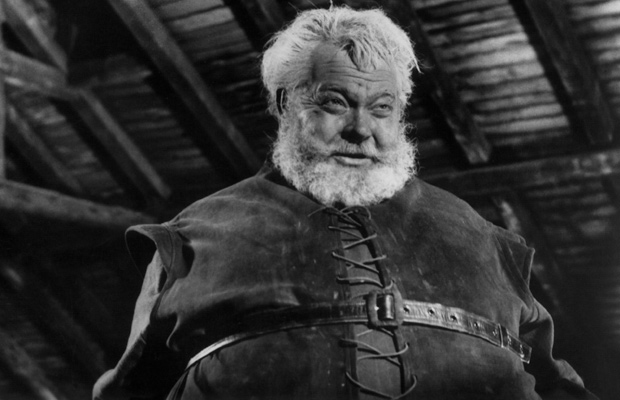Sweet Creature of Bombast: Welles’ Restored Homage to Shakespeare’s Ultimate Clown
Taking place from the years 1400 to 1408 in England, a narrator explains King Henry IV (John Gielgud) has succeeded Richard II’s thrown after killing him. The true heir to the throne is Edmund Mortimer, held prisoner in Wales. Mortimer’s cousins Northumberland (Jose Nieto), Worcester (Fernando Rey), along with Northumberland’s son Hotspur (Norman Rodway), demand Henry IV rescue Mortimer, but the new king refuses, leading to the plotting of his overthrow. Henry seems more bothered by his son Prince Hal’s (Keith Baxter) frequenting of the Boar’s Head Tavern, where the wayward youth spends all his time with rabble-rousers and prostitutes, influenced by famed overweight Svengali Sir John Falstaff (Welles).
Welles cobbles together his screenplay from five separate texts, including the three plays Shakespeare wrote where Falstaff actually speaks (Henry IV Part I and II, plus The Merry Wives of Windsor) as well as plot points from Richard II and Henry V. All of the dialogue comes from Shakespeare’s actual texts, with the exception of Ralph Richardson’s narration, which is crafted from the works of Raphael Holinshed, an English chronicler whose documents purportedly provided Shakespeare with inspiration on a number of his plays. The end result is an impressive and unparalleled exercise in the field of adaptation as Welles has mutated the original texts into his own unique creation of the tragic father figure, which logically inspired contemporary inspirations of Falstaff and Hal, as in Gus Van Sant’s My Own Private Idaho (1991). While Kenneth Branagh’s 1989 version of Henry V stands as the ultimate cinematic adaptation of one particular Henry text, acknowledgment is still owed to Welles earlier film version, particularly inspiring Branagh’s battle sequences.
Prior to Chimes, Welles had adapted Macbeth in 1946 and Othello (where he rather dubiously stars as the titular Moor, though he’s no less believable with an Irish accent in 1947’s The Lady from Shanghai) in 1952. But this labor of love actually had origins in the late 1930s as a stage play known as Five Kings, a play in two parts. Due to disastrous reviews in 1939, the second part was never staged, and Welles abandoned the project, revisiting it in 1960 as Chimes at Midnight and performing in Belfast and Dublin before low attendance caused its closure. In order to secure funding for the film, Welles infamously lied to Spanish producer Emiliano Piedra by promising to make an adaptation of Treasure Island concurrently in order to secure funding.
Sporting an impressive supporting cast, Welles taps French star Jeanne Moreau (who starred in his version of Kafka’s The Trial in 1962 as well as his last Euro film, 1970’s The Deep), as wonderfully named prostitute Doll Tearsheet and Sir John Gielgud as an ornery and immoral King Henry IV. In one of her last cinematic performances, Margaret Rutherford is a perfect wizened version of Mistress Quickly, while Fernando Rey and a young Marina Vlady (both apparently dubbed due to their thick accents) are also featured.
Keith Baxter as the impetuous Prince Hal, though reminiscent of Anthony Perkins onscreen, isn’t quite as effective, though it’s mostly due to being overshadowed by a hulking Welles as the jolly, manipulative Falstaff. Once you’ve seen his rendition, you’ll be hard-pressed to find a more suited performer for the role. But it’s easy to see why the film initially received criticism for sound track difficulties. Even in its current restored state, it’s difficult to catch some of Welles’ garbled or slurred moments as the old cur, but these moments don’t detract from his achievement in personification.
The film is the only credited production design by Mariano Erdoiza, while assistance from set decorator Jose Antonio de la Guerra (Francesco Rosi’s The Moment of Truth, 1965) enhances the particularly medieval look of the film. The design of the cavernous Boar’s Head Inn is particularly striking, a yawning ramshackle tavern juxtaposed magnificently with the mausoleum of a castle inhabited by Gielgud. Welles works once again with his DP from The Trial, Edmond Richard (also a favorite of Bunuel), and plenty of low angle shots capture the rotund Falstaff as a hulking, bear-like man. Deep focus moments in the corridors of the empty castle are filled with stark shadows cut by swaths of dusty light streaks, the architecture of each façade reflecting the sacrifices made by their inhabitants. But what stands as the most impressive sequence of all has to be the Battle of Shrewsbury, wherein Welles stages a battle sequence which earned him comparisons to Eisenstein and Kurosawa, including a detrimental face-off between Baxter’s Hal and Norman Rodway’s Hotspur as Falstaff watches from a safe vantage. It’s an abrupt switch from the looming, lurking close-ups of these mostly ragged characters, so richly photographed both head on and in profile.
One of the most notable cinematic Shakespearean adaptations ever mounted, Chimes at Midnight is at last available in a limited theatrical run, beginning in New York and Los Angeles before rolling out to select U.S. cities and eventually ascending to the ranks of the Criterion Collection.
★★★★/☆☆☆☆☆
